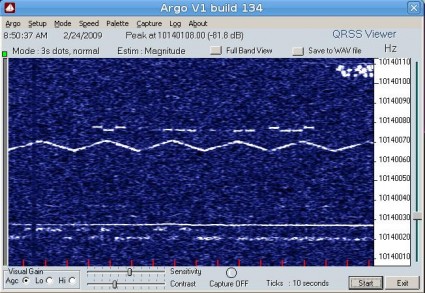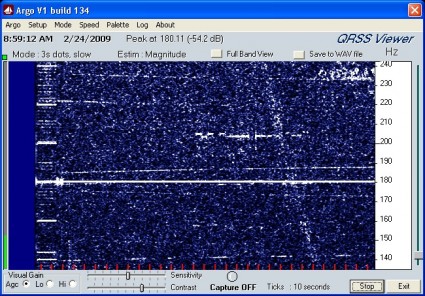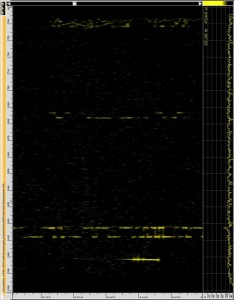New mode received by AA5CK
I had been experimenting with using S/MT Hellschreiber as a beacon format. It worked, and I got a few reception reports, but it’s copyability seemed pretty weak. I saw glimpses of it occasionally in the W8LIW and even VK6DI grabber, but it really wasn’t strong enough to call it decodeable. So last night, spurred on by a test that AA5CK had done, I decided to shift to DFCW.
DFCW is like FSK CW in that we send slightly different frequencies for dot and dash elements, but unlike FSK CW, DFCW uses the same timing for both dots and dashes. A small gap is inserted between elements (I used 1/3 of the dot time). Characters are separated by 1 dit time.
Because I simultaneously send a WSPR identifier, I wanted something that would fit in the 162 bit times that are specified by WSPR. If you write out K6HX and do some math, you will find out that you can use 8 WSPR bits per dit, and this comes out to dot timing of about 5.5 seconds, about 4.0 seconds of which are voiced.
Anyway, it turns out that if I just changed my S/MT table to a new table, I could do DFCW without change. This morning AA5CK sent me the following reception report from Oklahoma:
There I am, right above Larry’s Snake. The higher frequency should be read as dash; the lower, dots. Hence, you can read of “K6HX”. This should be much more copyable, and yet still fits in my 110 second WSPR message. I’ll leave this up for a few days, and we’ll see how it goes.
Addendum: I haven’t seen my signal on any other grabbers, but I think I am going to double the frequency offset. I think you should be able to see it clearly in most cases, but as I have seen with my most dx contacts, you can get a little bit of frequency instability that might make it more difficult to read.
Addendum: Chris sent me this screenshot:
Addendum2: Alan, VA3STL sent this screenshot of my beacon from his QTH near Ottawa:



I recall burning three or four weeks of a sabbatical getting Saccade.com on the air with Wordpress. So much tweaking…